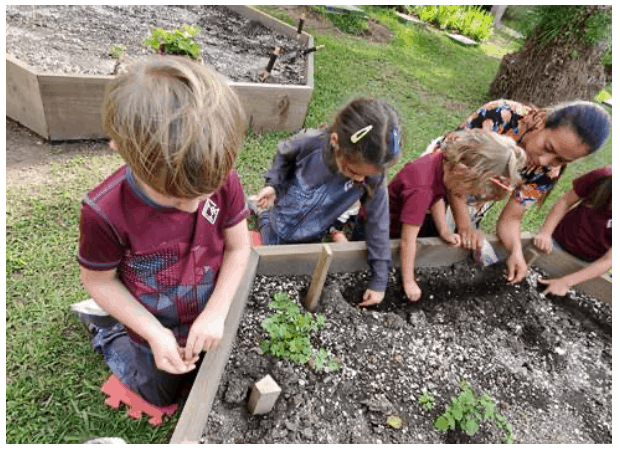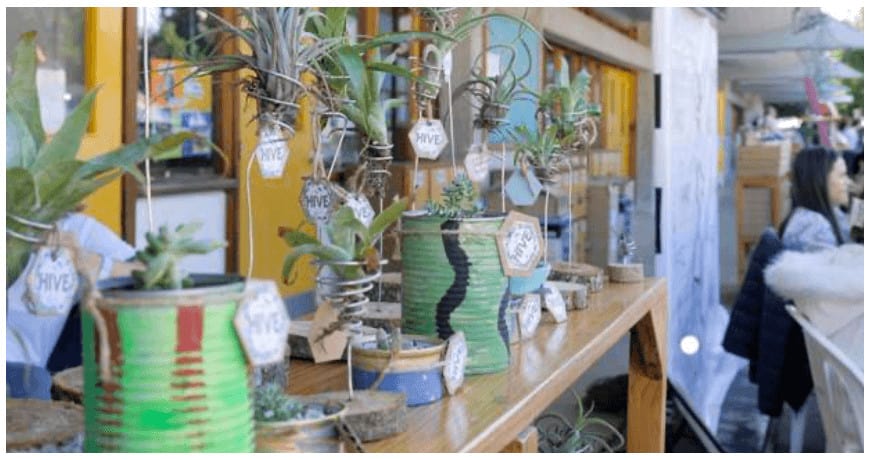Written by Michael Lein, Madison Weber, and Elizabeth Gourlis, American School of Guatemala.
What do you get when you give a plant dad, a succulent aficionado, and a seasoned gardener space? A mess. A dirt-encrusted, aromatic mess teeming with life, wonder, and endless opportunity for learning.
It all began eighteen months ago on midweek lunch break. We were three strangers, new to Guatemala and the international teaching circuit, chatting about hobbies and interests, when it became apparent that we all shared a passion for plants. A comment was made, half jokingly, about starting a garden at the American School of Guatemala, and that was that. The idea had been planted. What would grow in the following year and a half, though, none of us could have predicted.
From Seed to Seed
At the American School of Guatemala, we were given the freedom to pursue our passions, to find common ground on which to plant and grow: compassion for the environment, space for a garden, and a brand for this initiative. As its name suggests, The HIVE serves as a collective, connecting math curriculum with sustainable design, kindergarteners with high schoolers, vegetable gardening with cafeteria sales, and local staff with international teachers. In turn, these connections foster environmental sustainability and an appreciation for nature across campus.
While the garden is where many of these connections take place, this collective operates across campus. We knew that gardening alone did not possess enough sway for us to grow our initiative, so we branched out. The HIVE spread its roots to develop more inclusive programs and, in turn, welcomed more participants.
Who knew that a little bit of creativity could go such a long way? Classroom lessons, auditorium assemblies, cafeteria collaborations, gymnasium fairs, courtyard sales: The HIVE started to grow like a weed; as a result, campus was soon buzzing with talk of sustainability and our initiative. To channel this momentum and create a face to accompany the name, we employed one of the most basic principles of marketing: branding.
We petitioned a fellow new teacher to design a logo for us and could not have been happier with the results. Our logo, which seamlessly brings together our many visions for The HIVE, has served as the vehicle through which we connected the various programs and projects then taking root. This branding has allowed us to regularly showcase our students’ work in community newsletters, recruit new students and staff to join The HIVE in varying capacities, and further our education and connections by presenting at conferences throughout Latin America.
 New gardeners plant their first seeds in Garden Club (2019).
New gardeners plant their first seeds in Garden Club (2019).
Stretching Our Roots
Composting
We were thrilled this year to launch our composting program across campus, educating staff through workshops, tutorials, and the provision of bilingual resources. Even more exciting, though, is the interest and engagement of our student body, who have risen to the challenge, composting more organic waste than we can currently manage. We even have a few classes exploring the decomposition process, investigating alongside HIVE teachers the various stages of decomposition, the time it takes plants to break down, and the final product. 2020 already shows signs of growth, as January marks the beginning of our partnership with a local coffee shop to compost their used grounds and develop sustainable practices throughout the community.
Garden Club
Taking the form of a year long, after school extracurricular, our club welcomes 20 to 30 gardeners Kindergarten through fifth grade every week. It is here, in these seventy minute lessons, that inquiry drives, that wonder manifests, that passion for gardening develops. Our little scientists have grown and killed a variety of fruits, vegetables, herbs, flowers and weeds. They have dissected flowers, harvested seeds, transplanted sprouts, weeded beds, propagated succulents, compared soil compositions, harvested produce, and studied the difference between organic and chemically enhanced plants. They have used their senses to observe and model, and will continue to grow as scientists and gardeners in the coming year.
Challenges
Gardening might not be for everyone, but the environment certainly should be. To get more students involved, especially those who’d rather not dig in the dirt, we designed challenges to tackle a particular obstacle or project. Our first challenge required two sections of AP Calculus to design the layout of our raised beds in the garden. Students needed to measure the space, select a bed shape, and create a design that would optimize planting space without sacrificing aesthetics or accessibility. Our second challenge prompted high school art students to design and paint a set of wooden signs to delineate various areas of The HIVE. Our third challenge, debuting in 2020, will ask middle school math classes to design, model, and create rotating, mobile compost bins.
Sales
While the health of our plants is a top priority, it’s not the only green we must concern ourselves with. Like most startups, our funding was nonexistent when we began. A few bake sales and our new HIVE logo sticker business helped to alleviate some of the financial concerns. More notably, however, are the sales of the fruits or vegetables of our labor. Garden club students take part in the farm to table process by harvesting the plants they grow, cleaning them in the cafeteria, preparing them into salads, and selling them to staff on campus. Our little gardeners also recently showed off their green thumbs, having painted recycled tin cans and propagated over 100 succulents to sell at our school’s winter carnival.
 A sampling of succulents and airplants, painted and propagated by garden club kids, are on display at our winter carnival (2019).
A sampling of succulents and airplants, painted and propagated by garden club kids, are on display at our winter carnival (2019).
Waiting to Bloom
Just as a seed needs sun, water, and soil to grow, so too does an initiative rely on the time and effort of individuals to succeed. The growth of our initiative has been commended by our administration and school community; we are proud of what The HIVE has accomplished, but more so because we know what led to its success.
The construction of this collective has provided challenges that we did not anticipate: last minute expenditures, higher levels of stress, hundreds of hours of work. Building The HIVE has been no easy feat implementing change never is. Yet, difficulty does not excuse necessity. The world is at our students’ feet; it’s time they get acquainted with hard work and implementing change. And who knows, maybe they’ll even enjoy themselves in the beautiful mess around them.
You can read more articles like this in our new Curriculum Magazine:

